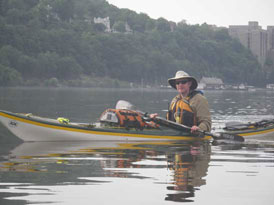Dagger is well-known for their whitewater kayaks. I truly believe that their touring kayaks are highly underrated. Most of their touring models never quite caught on, so you can buy them on the used market very cheap. The Cortez is a kayak that just has so much to love. It’s 15ft.-not too long, not too short. It is a fully equipped sea kayak designed for a smaller paddler. It handles like a true sea kayak with medium initial stability and high secondary stability. It comes with a rudder, dual bulkheads & hatches and full deck rigging. The cockpit is set slightly farther forward than most kayaks, giving the feel of a smaller boat. It isn’t particularly light weight or fast but it is a good all around touring kayak. My friend who paddles one takes it everywhere, including down the Delaware River. 15ft. 55 lbs.
 |
| Lou in his Cortez kayak- paddling with it full of water. |
Pros: Good fit for a smaller paddler. Handles a variety of conditions well. Relatively inexpensive on the used market.
Cons: Like all Dagger kayaks it is prone to dents and must be stored and transported carefully. A little on the heavy side. Can be hard to find one as not that many were manufactured.
See you on the water,
Don Urmston










